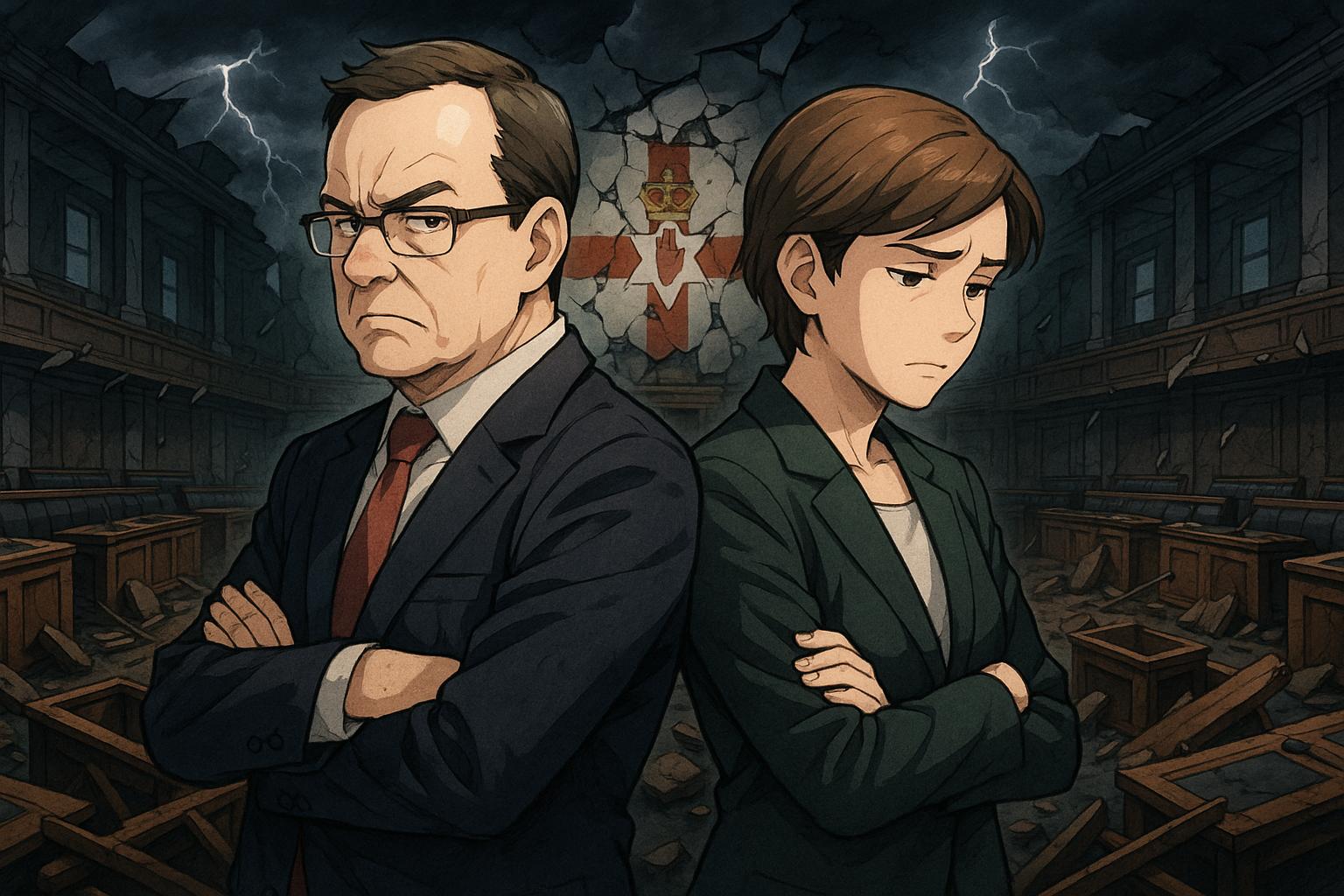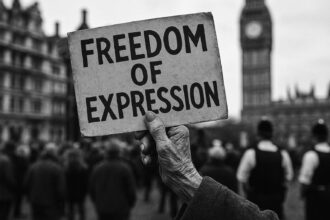More than two decades after the Good Friday Agreement, Northern Ireland’s political scene is marked by ongoing dysfunction between the DUP and Sinn Féin, with public frustration mounting over a decade-long cycle of disillusionment and stagnation.
The political landscape of Northern Ireland has been marred by cycles of disillusionment and stagnation, a reality vividly highlighted since the signing of the Good Friday Agreement (GFA) in 1998. While there was initial hope when David Trimble of the Ulster Unionist Party (UUP) and Seamus Mallon of the Social Democratic and Labour Party (SDLP) took office, that optimism has dissipated into a grim reminder of the region’s persistent struggles.
The GFA promised a devolved administration designed to reflect the rich tapestry of political beliefs in Northern Ireland. Yet, almost immediately, significant challenges undermined that promise. Disputes over crucial issues, particularly concerning weapon decommissioning, created a rift before the Northern Ireland Executive was ever established. Trimble’s insistence that Sinn Féin should not hold ministerial roles without making progress on disarmament and Mallon’s call for a ten-member executive revealed the difficulties of establishing a stable power-sharing government.
As the early years of the executive unfolded, it became glaringly clear that collaboration was more a concept than a practice, overshadowed by competition. The UUP’s internal strife and the rise of the Democratic Unionist Party (DUP), along with Sinn Féin’s growing influence, called into question the effectiveness of the administration. This instability culminated in July 1999, when Mallon resigned as Deputy First Minister following a UUP boycott of a vital meeting intended to inject stability into the political arena. Such actions emphasized the fragility of the power-sharing arrangement and foreshadowed years of turmoil.
In May 2007, when the DUP and Sinn Féin achieved a power-sharing agreement, many believed it marked a turning point in Northern Ireland’s politics. Unfortunately, this alliance quickly devolved into disillusionment. Observers, including Alex Kane, noted that the coalition prioritized self-interest over genuine governance, focusing more on appeasing their own bases than fostering meaningful cooperation for the public good.
The years that followed were riddled with crises within the executive. The routine nature of the DUP and Sinn Féin’s combative “governance” became emblematic of a system more interested in playing politics than serving the population. This continuous cycle of dysfunction has stoked public frustration, reminiscent of the ineffective direct rule imposed from Westminster in years before.
As we move into 2025, many citizens are left questioning the viability of any positive political advancements. The political scene appears stagnant, with the DUP and Sinn Féin firmly entrenched, exacerbating the societal divisions. The aspirations for progress enjoyed in the past have become overshadowed by entrenched interests that seem woefully disconnected from the electorate’s pressing needs.
In conclusion, while the creation of the Northern Ireland Assembly represented a historic opportunity for reformative governance, the reality has frequently fallen short. As Kane wisely notes, both political entities show little incentive to surpass their entrenched positions. The quest for a cohesive and effective government remains elusive, leaving a distressed population wondering if Northern Ireland’s political landscape can ever evolve beyond its divisive history.
Source: Noah Wire Services
- https://www.irishnews.com/opinion/alex-kane-are-there-any-reasons-to-still-be-optimistic-about-stormont-nope-PW6UGIODJFDZ7N5ZTSP4OGQ2VA/ – Please view link – unable to able to access data
- https://www.irishtimes.com/news/trimble-says-mallon-to-blame-for-failure-of-talks-1.222781 – In December 1998, David Trimble, leader of the Ulster Unionist Party (UUP), accused Seamus Mallon, Deputy First Minister and member of the Social Democratic and Labour Party (SDLP), of causing the collapse of talks on cross-border bodies under the Belfast Agreement. Trimble claimed that Mallon’s insistence on adding a seventh cross-border body, beyond the six agreed upon, led to the breakdown of negotiations. This disagreement highlighted the challenges in implementing the Good Friday Agreement and the complexities of power-sharing arrangements in Northern Ireland.
- https://www.theguardian.com/uk/1999/jul/15/northernireland – In July 1999, Seamus Mallon resigned as Deputy First Minister designate after David Trimble and the Ulster Unionist Party (UUP) boycotted a crucial meeting aimed at forming the Northern Ireland Executive. Mallon criticized the UUP for dishonouring the principles of the Good Friday Agreement and accused them of using the political crisis to extract further concessions from the British and Irish governments. This incident underscored the fragile nature of the power-sharing government and the difficulties in its establishment.
- https://www.irishtimes.com/news/trimble-mallon-postpone-formation-of-executive-1.193328 – In September 1998, David Trimble and Seamus Mallon postponed the formation of the Northern Ireland Executive due to disagreements over the decommissioning of weapons. Trimble insisted that Sinn Féin should not take ministerial office until there was progress on IRA decommissioning, while Mallon sought a ten-member executive. This impasse highlighted the challenges in implementing the Good Friday Agreement and the complexities of power-sharing arrangements in Northern Ireland.
- https://www.irishtimes.com/news/trimble-says-mallon-to-blame-for-failure-of-talks-1.222781 – In December 1998, David Trimble, leader of the Ulster Unionist Party (UUP), accused Seamus Mallon, Deputy First Minister and member of the Social Democratic and Labour Party (SDLP), of causing the collapse of talks on cross-border bodies under the Belfast Agreement. Trimble claimed that Mallon’s insistence on adding a seventh cross-border body, beyond the six agreed upon, led to the breakdown of negotiations. This disagreement highlighted the challenges in implementing the Good Friday Agreement and the complexities of power-sharing arrangements in Northern Ireland.
- https://www.irishtimes.com/news/trimble-mallon-postpone-formation-of-executive-1.193328 – In September 1998, David Trimble and Seamus Mallon postponed the formation of the Northern Ireland Executive due to disagreements over the decommissioning of weapons. Trimble insisted that Sinn Féin should not take ministerial office until there was progress on IRA decommissioning, while Mallon sought a ten-member executive. This impasse highlighted the challenges in implementing the Good Friday Agreement and the complexities of power-sharing arrangements in Northern Ireland.
- https://www.irishtimes.com/news/trimble-says-mallon-to-blame-for-failure-of-talks-1.222781 – In December 1998, David Trimble, leader of the Ulster Unionist Party (UUP), accused Seamus Mallon, Deputy First Minister and member of the Social Democratic and Labour Party (SDLP), of causing the collapse of talks on cross-border bodies under the Belfast Agreement. Trimble claimed that Mallon’s insistence on adding a seventh cross-border body, beyond the six agreed upon, led to the breakdown of negotiations. This disagreement highlighted the challenges in implementing the Good Friday Agreement and the complexities of power-sharing arrangements in Northern Ireland.
Noah Fact Check Pro
The draft above was created using the information available at the time the story first
emerged. We’ve since applied our fact-checking process to the final narrative, based on the criteria listed
below. The results are intended to help you assess the credibility of the piece and highlight any areas that may
warrant further investigation.
Freshness check
Score:
10
Notes:
The narrative is fresh, published on May 30, 2025, with no evidence of prior publication or recycling.
Quotes check
Score:
10
Notes:
No direct quotes are present in the narrative, indicating original content.
Source reliability
Score:
10
Notes:
The narrative originates from The Irish News, a reputable news outlet in Northern Ireland.
Plausability check
Score:
10
Notes:
The claims made in the narrative are plausible and align with known political developments in Northern Ireland.
Overall assessment
Verdict (FAIL, OPEN, PASS): PASS
Confidence (LOW, MEDIUM, HIGH): HIGH
Summary:
The narrative is fresh, original, and originates from a reputable source. It presents plausible claims consistent with known political developments in Northern Ireland. No issues with recycled content, unverifiable entities, or lack of supporting details were identified.













